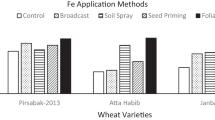Abstract
A field experiment was conducted during 1999–2000 to study the response of sugarcane varieties to iron nutrition at Sugarcane Breeding Institute, Coimbatore, India. The main plot treatments consisted of soil application of four levels of ferrous sulphate (0, 75, 150 and 225 kg/ha) and foliar application of ferrous sulphate (2%) thrice during tillering stage at weekly intervals. Six varieties, viz. Co 8021, Co 8371, Co 86010, Co 86032, Co 86249 and Co 87025 formed the sub-plot treatments. The soil of the experimental field was sandy clay loam in texture with pH of 8.47, EC of 0.67 dSm-1 and calcium carbonate content of 8.04%. It was deficient in iron, but adequate in zinc, manganese and copper. Soil available iron and iron content in leaf blade at tillering stage were quantified and juice sucrose content and yield were assessed at harvest. Soil available iron at tillering stage was improved by soil application of ferrous sulphate at 150 and 225 kg/ha over control. The iron content of leaf progressively increased with levels of ferrous sulphate soil application. But foliar application was more effective in improving iron content of leaf and in alleviating the chlorosis. Cane yield was influenced by ferrous sulphate treatment and foliar application recorded the highest mean cane yield of 92.24 t/ha and was on par with 150 and 225 kg/ha soil application. Higher yield response to foliar application of ferrous sulphate compared to soil application could be due to the higher calcium carbonate content of the soil. Variety Co 86032 recorded the highest cane yield of 99.17 t/ha followed by Co 8021 and Co 86249 while Co 86010 recorded the lowest yield (76.69 t/ha) and was at par with Co 87025(78.47t/ha). Varieties Co 87025, Co 86010 and Co 8371 showed good response to ferrous sulphate treatment with an yield improvement of 26.87, 17.83 and 23.1 t/ha, respectively at 2% foliar spray/225 kg FeS04/ha soil application, revealing their susceptibility to iron deficiency. Varieties Co 86032, Co 8021 and Co 86249 showed only a marginal yield improvement to ferrous sulphate application indicating their tolerance to iron deficiency. Co 86032 recorded higher cane yield (94.63 t/ha) than other varieties except Co 8021 under control. The varieties Co 86032 and Co 8021 could be recommended to iron deficient soils.
Similar content being viewed by others
Reference
Anderson, W.B. (1982). Diagnosis and correction of iron deficiency in field crops-An overview.J. Plant Nutr.,5: 785–720.
De, R. and Singh, R. (1960). effect of micronutrient elements on growth, yield and chemical composition of sugarcane.Soil Sci.,89: 97–100.
Govindaraju, D. (1994). Studies on fixing up of critical limits of iron for soils and sugarcane. M.Sc (Ag.) dissertation, Tamil Nadu Agric. Univ., Coimbatore.
Kapur, M.L. and Kanwar, R.S. (1988). Yield, quality and nutrient composition of sugarcane as influenced by application of micronutrients.Proc. Ann. Conv. Sug. Technol. Assoc. (India),51: 35–38.
Lindsay, W.L. and Norvell (1978). Development of DTPA soil test for Zn, Fe, Mn and Cu. Soil Sci. Soc. Am. Proc.,42: 421–428.
Marsh, H.V., Evans, H.J. and Matrone, G. (1963). Investigation of role of iron in chlorophyll metabolism.Plant Physiol.,38: 632–638.
Meade, G.P. and Chen, J.C.P. (1977). Cane sugar Hand book. Tenth Edition. A Wiley-Intersciency Publication, John Wiley and sons, New York.
Miller, G.W., Denney, A., Pushnik, J. and Yu, M.H. (1982). The formulation of delta amino levulinate: a precursor of chlorophyll in barley and the role of iron.J. Plant Nutri.,5 : 289–300.
Naik, G.R. and Joshi, G.V. (1982). Response of different sugarcane cultivars to iron stress.Proc. DSTA. Conv.,33: 77–80.
Palanivel, A. (1990). Effect of soil and foliar applied iron on sugarcane in calcareous soil.Indian Sug.,40: 117.
Patil, V.M. and Somawanshi, R.B. (1983). Correction of iron chlorosis in sugarcane on saline-calcareous soil.Commun. Soil Sci. and Plant Anal.,14: 471–480.
Pratt, P.F. (1967). Methods of soil analysis, part II. Agronomy, C.A. Blask (Ed). 1019–1221 Am Soc. Agron., Madison, USA.
Rakkiyappan, P. (1986). Survey of micronutrient status of sugarcane growing tracts in relation to different varieties. Ann. Rep. 1986. Sugarcane Breeding Institute, Coimbatore.
Rakkiyappan, P. and Thangavelu, S. (1996). Effect of iron on sugarcane productivity and its juice quality as raised in soils from cane areas of some sugar factories.Indian Sug., 46: 761–768.
Rakkiyappan, P. and Thangavelu, S. (2000). Effect of iron on ratoon crops of six sugarcane varieties grown in iron deficient soil. Proc. International Conference on Managing Natural Resources for Sustainable Agricultural Production in the 21 st century. February, 14–18, 2000, New Delhi, India pp 266–268.
Savangikar, V.A., Chitra Savangikar, Kale, V.R. and Zende, G.K. (1999). Micronutrient requirements of sugarcane for yield maximization.Co-op. Sug.,30: 1055–1062
Singh, R.G. (1972). On the microelements of sugarcane.Co-op. Sug.,4: 5–12.
Terry, N. and Low, G. (1982). Leaf chlorophyll content and its relationship to the intercellular localization of iron.J. Plant Nutr.,5: 301–310.
Yadav, D.V., Singh, T. and Singh, K. (1987). Response of sugarcane to foliar application of micronutrients.Indian J. Sugarcane Technol.,4: 42–46.
Author information
Authors and Affiliations
Corresponding author
Rights and permissions
About this article
Cite this article
Rakkiyappan, P., Thangavelu, S. & Radhamani, R. Effect of ferrous sulphate on sugarcane varieties grown in iron deficient soil. Sugar Tech 4, 33–37 (2002). https://doi.org/10.1007/BF02956877
Published:
Issue Date:
DOI: https://doi.org/10.1007/BF02956877



